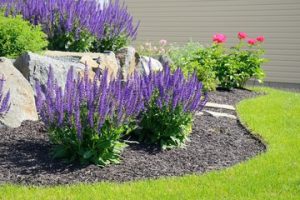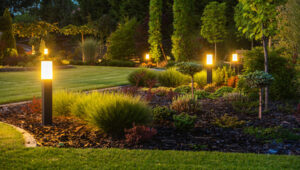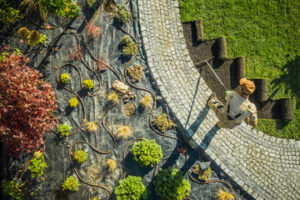Adding flowers, plants and structures to outdoor spaces creates a welcoming environment. It also increases a home’s value and offers practical benefits like shade, privacy, and control of erosion.

Learn how to landscape your home for maximum beauty and function. Start by defining your goals for the space, whether it’s to improve resale or simply make the yard more enjoyable and life friendly. Visit https://oceaniclandscaping.com/ to learn more.
Plants are an important part of any landscaping project. They add color, texture, and depth to the landscape. They also provide many environmental benefits, such as reducing erosion and improving air quality.
Landscaping professionals know how to choose the right plants for any area. They also understand the importance of using different colors to create contrast and create a sense of movement. For example, warm colors like red, orange, and yellow can make objects feel closer while cool colors such as green, blue, and purple can create a more tranquil feeling.
Another crucial part of landscaping is trees. Trees are a great way to add privacy and beauty to a yard. They also help to keep the environment healthy by removing carbon dioxide and adding oxygen. Landscapers are often hired to maintain these trees by removing dead branches and leaves. They also help to keep water bodies clean by aerating ponds and lakes.
A beautiful and well-maintained landscape can increase the value of a home or business. It can also improve energy efficiency by shading buildings and reducing the need for air conditioning. It can also help reduce noise pollution by absorbing and deflecting sound waves.
Commercial landscaping is an important part of any business. It can create a positive work atmosphere by providing a calm and soothing environment for employees and clients. It can also attract new customers by creating a memorable first impression.
When choosing a landscaping company, it is important to look for one that has experience and a good track record. It is also important to check the licenses and insurance of the company before hiring them.
Green spaces are treasured all over the world, and they are a vital part of any community. Access to these areas can be a major lifeline for people living in cities, where there are few natural spaces. Landscapers are tasked with maintaining these beloved green spaces, which is a job that they take seriously. They are constantly working to keep these areas pristine and beautiful, which requires hard work and dedication.
Hardscapes
A well-designed hardscape is essential to a landscape’s overall appeal. Hardscapes include features such as paved areas, walkways, retaining walls, patios and more. These components are largely made of solid materials such as concrete, brick and stone. They offer a stark contrast to the softness of plants, helping your landscape stand out.
In addition to their aesthetic value, hardscapes can also serve a practical purpose. For example, a well-placed retaining wall can help improve drainage and prevent erosion on your property. Other practical hardscape features include water features, which can be used for both decoration and irrigation purposes, and structures, such as pergolas, that create shade, reducing the need for air conditioning and promoting energy efficiency in your home.
One of the most important things to consider when designing your hardscape is its placement. As a rule, you want to avoid making your hardscape the focal point of your yard. Instead, use it to complement and highlight your landscaping. For instance, a curved stone pathway can make an attractive and functional addition to your yard by drawing the eye to various plants and creating visual interest.
Another way to incorporate hardscapes is through the use of different textures. This is an easy way to add variety and interest to your space. For example, pavers with unique shapes and colors can help create an appealing design. They can be combined with other elements, such as a wooden bench, to create a cohesive and visually appealing design.
There is a certain art to designing effective hardscapes, and it requires the expertise of a professional. Your landscaper should have a good understanding of scale, proportion and balance when determining where to place your hardscapes. They should also be able to seamlessly integrate your outdoor living spaces with the rest of your property’s landscape.
By incorporating the right hardscapes into your backyard, you can enjoy it all year round. From winding paths to fire pits, these features will ensure that your yard is still a welcoming space in winter, so you can continue entertaining guests or spending time with your family outdoors.
Visual Details
Whether they are subtle or overt, visual landscape elements can make or break a landscape design. Understanding how these elements interact with each other is vital in designing a cohesive and harmonious space that appeals to all of the senses. Some of the most important visual landscape elements include shape, form, line, color, texture, and scale.
A landscape design layout is the blueprint that guides the arrangement of plants, walkways, patios, and other landscape features. It ensures harmony between different elements, increases property value, and provides a clear visual representation of the overall design. It is a crucial part of the landscape design process and should be drawn to scale, using a high-quality drawing material for accuracy. For most residential properties, a scale of 1:10 (1 inch = 10 feet) works best.
In addition to their physical properties, landscape elements have emotional and psychological effects on people. For example, the shape and texture of a plant can affect the way people perceive it, while the sound of a stream can evoke emotions. The use of landscape elements is also a great way to add character and personality to a property.
The most common methods of visual analysis in landscape architecture include freehand sketching, photography, and computer-aided design (CAD) software. CAD software enables the designer to create models of a landscape, allowing for an in-depth analysis and comparison of different design scenarios. Detailed photography allows for the collection of data that can be analyzed and compared over time. Photographs can be used to evaluate landscape quality, as well as record and document the results of an on-site observation.
Social media has become a powerful tool in public perception research and landscape visual quality assessment. The considerable potential of uploaded photographs has led to the development of a method for photograph content analysis, which enables a deep comprehension of what observers portray and explores the landscape attributes that attract people. A number of factors are associated with the preference for a particular landscape attribute, including the age, gender, and cultural background of the photographer.
Scents
Scents are important because the sense of smell connects directly to the part of the brain that holds emotions and memories. Creating scents that are soothing and pleasant is a critical part of landscape design. For example, a fountain with fragrant star jasmine (Jasminum officinale) around it can combine the visual appeal of water with a delightful floral aroma. Or, a shrub or tree such as a mock orange (Philadelphus lewis) with year-round fragrant leaves can provide the same effect.
Plants with a tangy fragrance such as tea olive (Olea europaea) can be combined with fragrant plants like freesias to create beautiful “scent waves” in your garden. Or, a climbing vine like Chinese hibiscus (Hibiscus rosa-sinensis) can fill the air with a sweet, tropical scent.
A successful landscape invites your guests to interact with all five senses. A landscape designer is trained to ensure your landscape provides an experience for all of them, and the sense of touch plays a key role in this. A stepping stone pathway that is smooth and comfortable to walk on will be more inviting than one that has the crunch of dried leaves or seeds.

